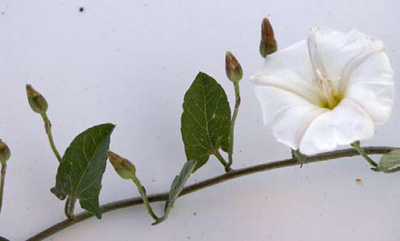Convolvulaceae (Morningglory fam.)
At a Glance
- Perennial
- Vine with twisted stems up to 4-6 feet long, often grows on other upright plants
- Leaves are alternate and arrowhead-shaped
- Flowering occurs approximately June-September
- White-pink, trumpet-shaped flowers open each morning and close each afternoon
- Possesses a deep tap root and shallow, horizontal lateral roots
- Exotic

Patrick J. Alexander, hosted by the USDA-NRCS PLANTS Database
Habitat and Ecology
Field bindweed, Convolvulus arvensis, is found throughout the U.S., except for the extreme Southeastern U.S. and southernmost parts of Arizona, New Mexico, and Texas (Idaho Association of Soil Conservation Districts 2008). A native of Eurasia, the plant most likely was brought to the U.S. as a contaminant in farm and garden seeds (University of California Agriculture and Natural Resources 2003). Some seeds were probably also planted as ornamentals. Field bindweed is an adaptable plant that does well in many habitats, including arid regions. It is frequently found in disturbed and managed (mowed) areas.

USDA
Description
Field bindweed is a perennial vine that dies back each year (Idaho Association of Soil Conservation Districts 2008). Its twisted stems are often found growing on other upright plants. Its white to pink flowers start to appear in June. The plant reproduces both from seed and creeping roots, with seeds remaining dormant in the soil for up to 60 years. Field bindweed possesses both a deep tap root and shallow horizontal lateral roots (University of California Agriculture and Natural Resources 2003). A single plant is able to spread outward more than 10 feet (3 meters) in one growing season.

Tom Heutte / USDA / Bugwood.org
Leaves
Leaves are alternate, up to 2 inches (5.1 cm) long, and generally arrowhead-shaped (Texas A&M University 2003). Older leaves at the base of the stem are larger than the younger leaves at the end of the stem (University of California Agriculture and Natural Resources 2003). On a field bindweed seedling, the first two leaves are nearly square and have a shallow notch at the tip. Plants that arise from rhizomes do not have these leaves. The first true leaves show the characteristic arrowhead shape and possess leaf stems that are flattened and grooved on the top surface.

Steve Dewey / Bugwood.org
Flowers and Seeds
The white to pink, trumpet-shaped flowers open each morning and close each afternoon. The 1-inch- (2.5-cm) wide flowers are borne in leaf axils from June to September (Idaho Association of Soil Conservation Districts 2008). A pair of small bracts appear about 0.25 to 1 inch (0.6-2.5 cm) below each flower.
The seeds of field bindweed are dark brown, with 1 to 4 seeds being held in round, smooth capsules 0.25 inches (0.6 cm) in size (University of California Agriculture and Natural Resources 2003). On average, about 550 seeds are produced per plant. The long-surviving seeds make management of the species difficult (Texas A&M University 2003; Idaho Association of Soil Conservation Districts 2008).
Similar Species

Lynn Sosnoskie / Bugwood.org
Field bindweed is easily distinguished from the ornamental annual morningglory (University of California Agriculture and Natural Resources 2003). The ornamental morningglory has a larger (2 inch- [5.1 cm] wide) flower that is white to blue or purple. It also has a thicker stem, that may be hairy, and heart-shaped leaves that are 2 inches (5.1 cm) long or longer. Wild buckwheat (Polygonum convolvulus) is another plant whose trailing stems may be mistaken for field bindweed stems (University of Californina Agriculture and Natural Resources 2008); however, its leaves are more pointed than those of field bindweed.
Etymology

W.S. Justice / Smithsonian Institution
The name “convovulus” means to entwine, and “arvensis” means of fields (Gray 1970).
Prepared by Patricia Valentine-Darby, Southern Colorado Plateau Network Inventory and Monitoring Program, 2009.
Last updated: May 3, 2016
